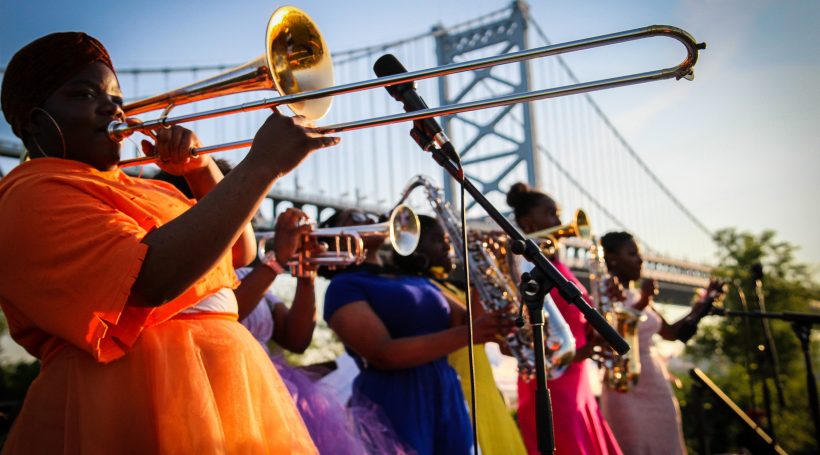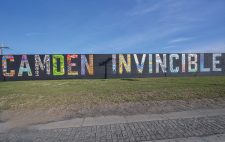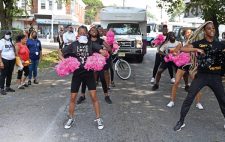Presented by Cooper’s Ferry Partnership
 When you’re trying to turn your city into the appealing neighborhood and destination you know it can be, every bit of collaboration and commitment helps. Camden officials are well on the way to developing partnerships and uniting resources to build up a city already on the rise.
When you’re trying to turn your city into the appealing neighborhood and destination you know it can be, every bit of collaboration and commitment helps. Camden officials are well on the way to developing partnerships and uniting resources to build up a city already on the rise.
f you look into the future of Camden, you’ll see huge swaths of green space where families can play, picnic and participate in activities designed to promote a healthy community. It’s a future that’s within reach thanks to the effective partnerships between state and local government, Cooper’s Ferry Partnership, and several businesses and nonprofits. These groups – some in the city, some not – all have big plans to make this future a reality
One of the biggest needs when you’re turning vacant lots and dilapidated fields into vibrant parks is funding; quite a bit, in fact. When available public resources are stretched too thin, it’s often outside foundations that make up the difference, building relationships with local nonprofits and neighborhoods.
“We’re seeing a growing trend of individual philanthropists and national or regional foundations making targeted investments in open space and creative placemaking,” says Congressman Donald Norcross.
“They are investing in parks – either in the physical rebuild of a space or in the programming that brings it to life,” says Kris Kolluri, president and CEO of Cooper’s Ferry Partnership. “There are a few foundations that have been doing this in Camden for the past few years, and it’s been under the radar.”
One of the largest grants to support the development of public spaces came from the Philadelphia-based William Penn Foundation. Last December, they invested $1.5 million for the capital construction of the RCA Pier Park in front of American Water’s new headquarters. This was the first – and largest – private capital investmment in the past few decades.
The foundation also invested $1.8 million to support the planning and construction of an expansion of The Circuit Trails, a 750-mile network of walking and biking trails that snakes through NJ and PA. When the construction of a ramp on the Camden side of the Ben Franklin Bridge opens this spring, the Circuit Trails will connect Camden directly to Philadelphia.
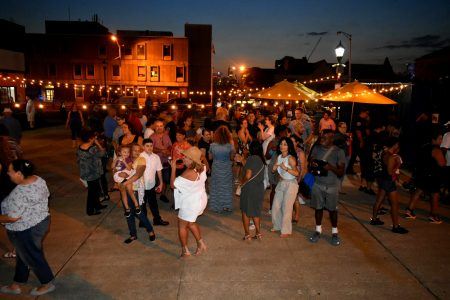 Freeholder Jeffrey Nash says the William Penn Foundation is one of the biggest supporters and advocates for the regional trail network and Delaware River Watershed in the region, as well as a partner with Camden City.
Freeholder Jeffrey Nash says the William Penn Foundation is one of the biggest supporters and advocates for the regional trail network and Delaware River Watershed in the region, as well as a partner with Camden City.
“They’ve been investing in parks and open space in Philadelphia for many years, and we were able to start a conversation about making a capital investment on the Camden side,” he says.
“They’ve funded greenways and trails, and projects focused on the Delaware River watershed and reconnecting communities to the river,” adds Camden Mayor Frank Moran.“We’re taking an area that was a parking lot and turning it into an engaging waterfront park. It’s a unique opportunity, where we’re able to preserve a huge piece of property right on the water.”
Other green spaces in Camden have benefitted from the interest of major philanthropic foundations in the region too. Bloomberg Philanthropies – founded by former New York Mayor Michael Bloomberg – awarded the city a $1 million grant for “A New View,” a public art project that will transform sites plagued by illegal dumping into dynamic art spaces.
“Public art has the power to bring people together to strengthen their communities. Camden is harnessing that power by transforming dumping sites into works of art along the city’s public transit routes, which will symbolize –
and further spur – the city’s ongoing resurgence,” says Bloomberg. “I’m glad to congratulate Camden on being a winner of our Public Art Challenge.”
Another $1 million grant was recently awarded by the Norcross family, The Michaels Organization, NFI, Conner Strong and Buckelew, and The Cooper Foundation. The new program will provide $200,000 per year for each of the next five years to Camden non-profit community organizations. Conner Strong, NFI, and The Michaels Organization will move their headquarters to the city this summer.
“Our experience building and rebuilding communities across the country,
with a focus on enhancing the lives of our residents, has taught us how important non-profit community groups are to strengthening and enriching communities,” says Susan Bass Levin, CEO of the Cooper Foundation.
“We are proud to be part of this new effort, we are excited to move into our headquarters in June and thrilled to be a part of Camden’s future,” says John O’Donnell, CEO of The Michaels Organization.
Additionally, former Eagles quarterback Ron Jaworski’s foundation – Jaws Youth Playbook – made a $100,000 investment in 4th and Washington Park.
“Ron Jaworski’s mission is to have safe places for kids to play,” says Trish Cuadrado, the executive director of Jaws Youth Playbook.
Parks, Cuadrado says, are vital for children’s healthy development. “Being able to play in a park shapes how kids exercise, how they socialize,” she says.
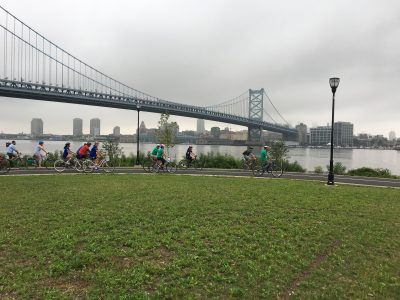 The connection between parks and healthy kids is one the Horizon Foundation for New Jersey recognizes, too.
The connection between parks and healthy kids is one the Horizon Foundation for New Jersey recognizes, too.
“The Horizon Foundation for New Jersey was created in 2004, and since then, the foundation has invested around $55 million statewide to 501c3 organizations,” says Jonathan Pearson, the foundation’s executive director. “Over that time, in Camden specifically, we’ve made 96 grants and invested just over $3 million.”
Some of those grants have funded traditional healthcare initiatives, but Pearson says there are a lot of other factors that contribute to a community’s health.
A $25,000 grant from The Horizon Foundation for New Jersey funded the Roosevelt Plaza Park project, outside Camden’s City Hall.
“Funders and organizations like Campbell Soup, American Water, L3 Communications, Virtua, Dodge Foundation, Kresge Foundation, and Our Lady of Lourdes have been making investments in communities to support revitalization and program the parks with different activities focused on arts and health initiatives,” Kolluri says, noting this kind of programming is what “animates” a park.
“We’ve started to collect a lot of data on this,” he says. “We’ve been able to increase usage in these parks by significant numbers. That, and increasing opportunity for engagement and healthy recreation in these parks, are our objectives.”
“Other grants include the multi-year awards that the Wells Fargo Regional Foundation invests in several city neighborhoods like North Camden, Cramer Hill, East Camden, and Parkside to support neighborhood revitalization. These multi-million dollar grants are focused on the creation and implementation of resident-driven neighborhood plans.”
And the Robert Wood Johnson Foundation awarded $93,000 to a number of Camden partners to develop an online mapping tool, which will provide a meaningful planning tool for city leaders.
The future of Camden, Kolluri says, will be built on partnerships between Cooper’s Ferry, the foundations investing in the city, and – most importantly – the people who live there.
“Part of our job is to raise resources and invest them in the city,” Kolluri says.
“That means making sure that whatever the resource, whether it’s a foundation or a public or private investment, that dollar has a high impact. We want to make sure we’re achieving all the goals and outcomes we projected when we asked for that dollar.”
The best way to ensure that kind of success is to directly involve the community members the investment will most benefit.
“It’s really not about the money,” says Deb Degillio, president of NJ American Water. “It’s about how we can be strategic, thoughtful, and intentional about where we place our dollars and how we choose our partners. That all weaves together to create a larger positive impact on the community members who live in Camden.”
It’s also not just about building parks.
“These foundations invest in policies and community engagement,” Kolluri says. “Out of these plans come strategies for what the residents in the community want to see for their neighborhoods. They include conversations and engagement with the community to get them directly involved. That’s usually the first step.”
And that direct connection between the foundations supporting Camden’s communities and the people who reside in them is often fostered by the Cooper’s Ferry Partnership.
“Cooper’s Ferry is the best relationship we have with people who say what they’re going to do and then actually execute it,” Cuadrado says. “They give the community ownership of projects. They reach out to the people first and foremost and ask what they want for their park. After all, they’re the ones who are going to be using it.”
It’s a unique approach to a city’s renaissance that the Cooper’s Ferry Partnership calls “inclusive prosperity.”
“It’s more than a dollar,” Kolluri says. “It’s a relationship. We talk a lot about the fact that the story of Camden’s revitalization has many chapters. It’s a book that’s still being written. It’s telling a story about how Camden is a city on the rise.”


